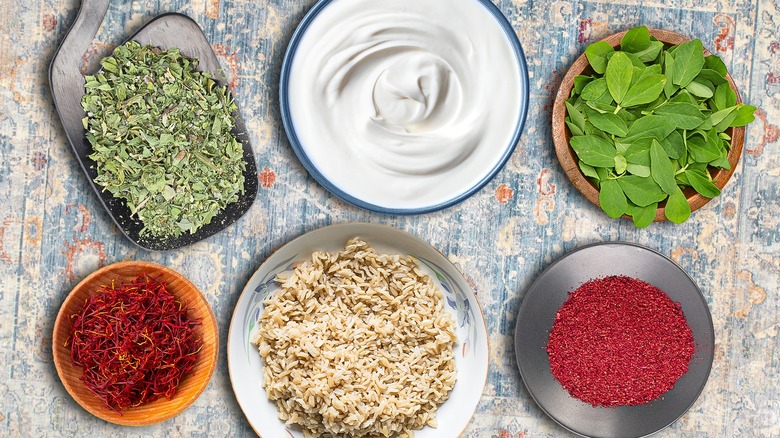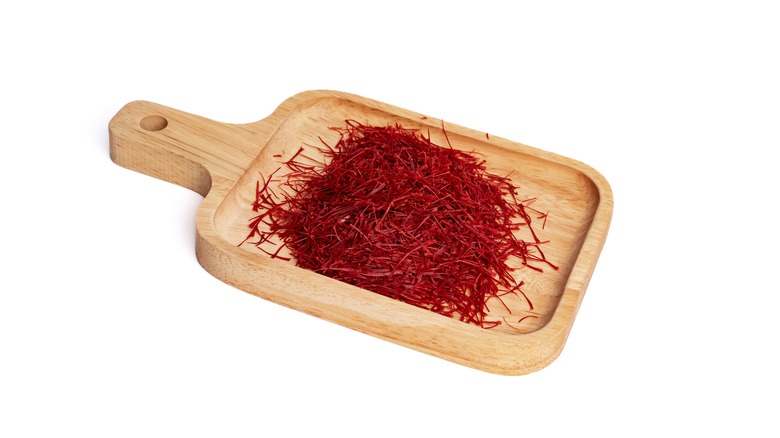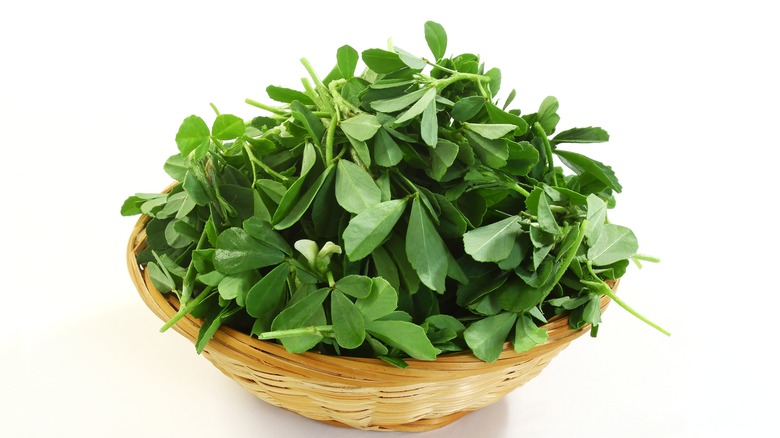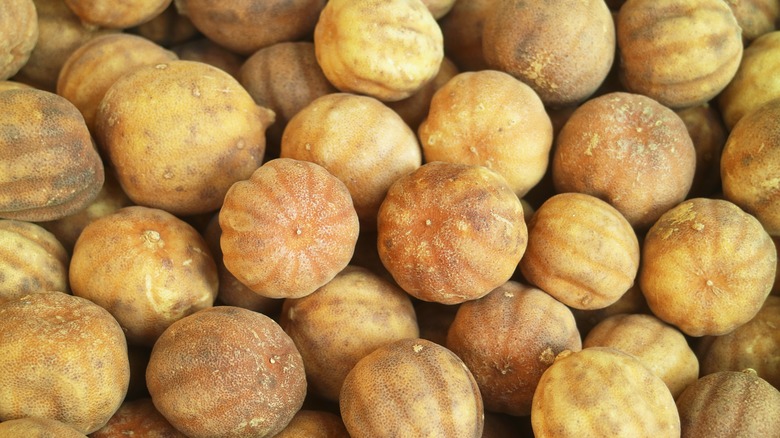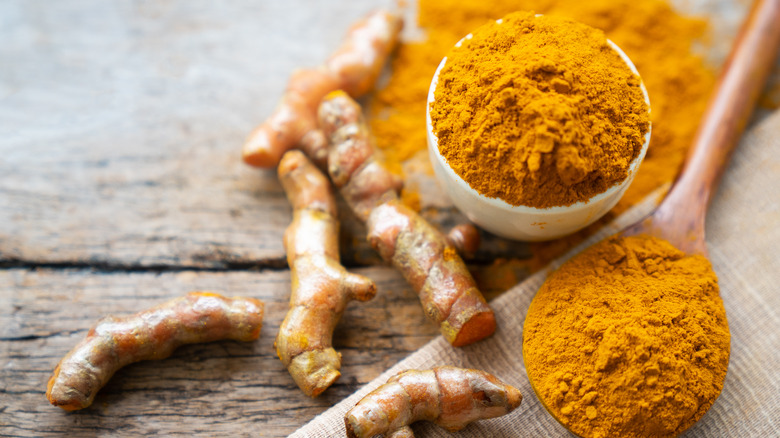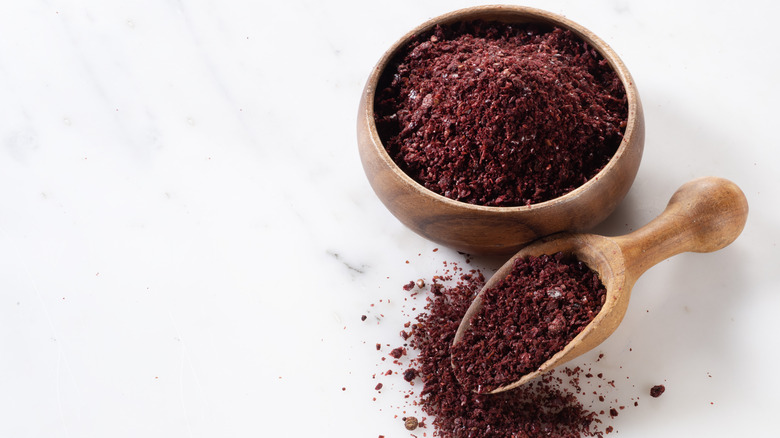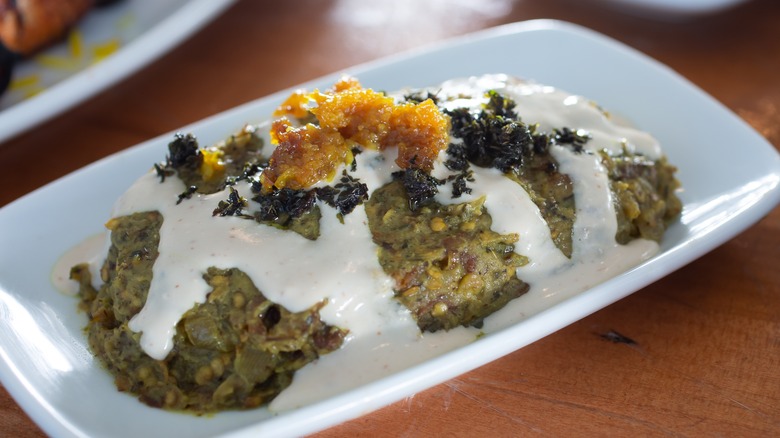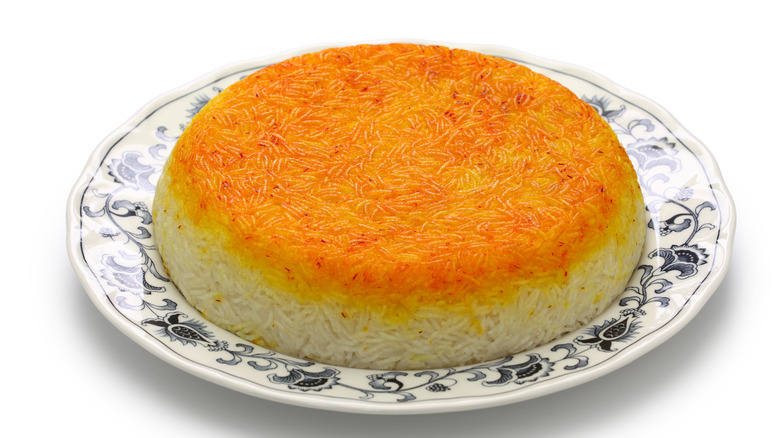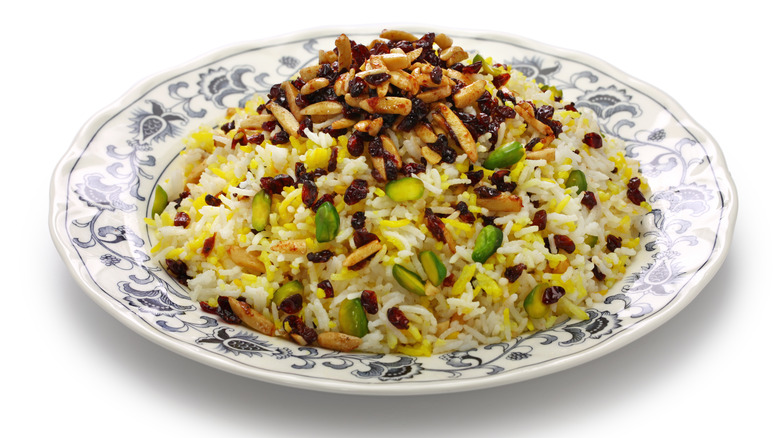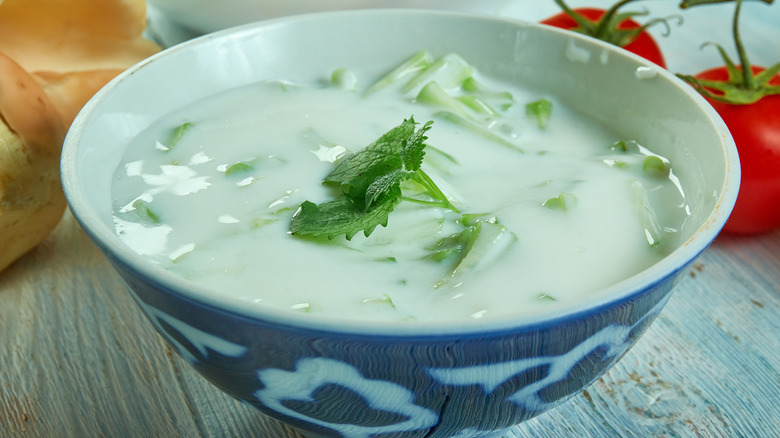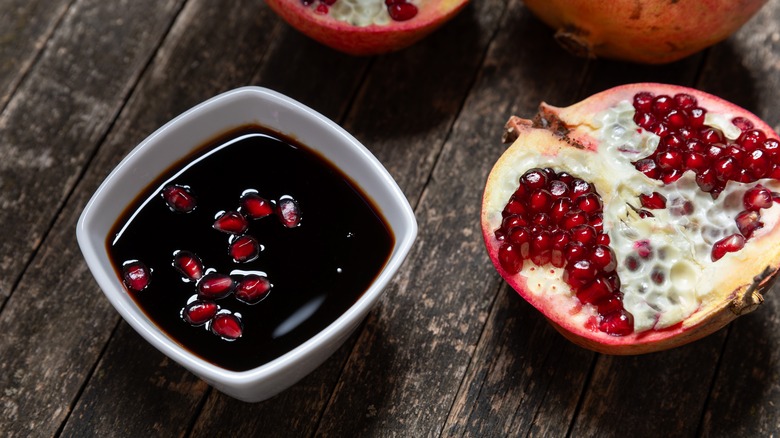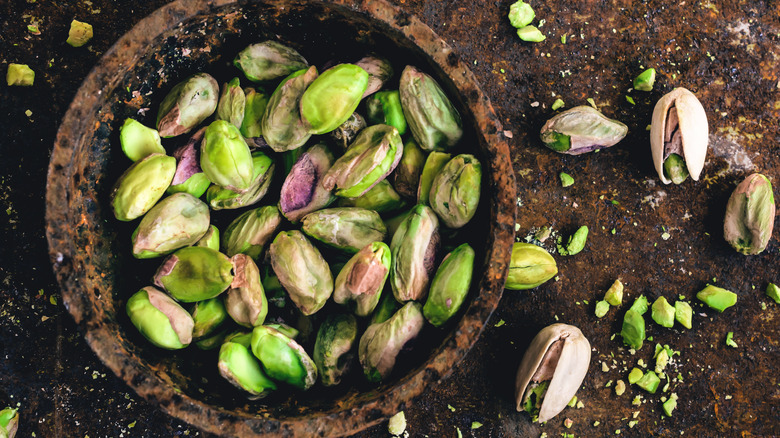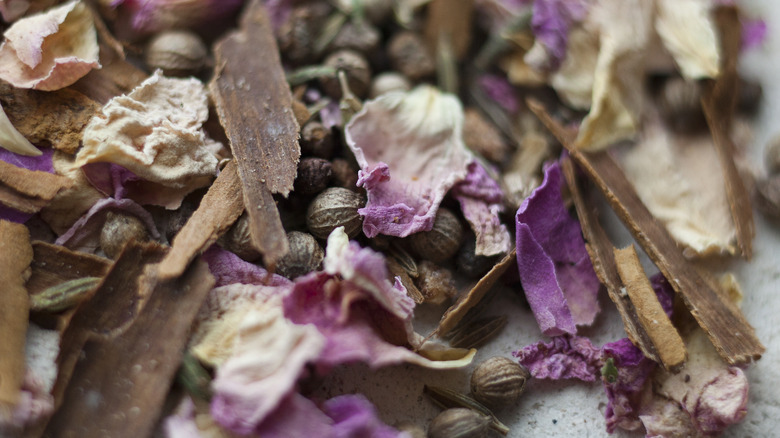12 Must-Have Ingredients For Great Persian Food
For people who aren't intimately connected to Persian culture, kebabs may be the first thing that comes to mind when thinking of the cuisine. Don't get me wrong, kebabs are delicious, and part of the beloved Persian recipes that make up the vast repertoire of Persian cooking — but it would be a shame to stop there, as there is much more diversity in Persian cuisine, and a whole world outside of kebabs to explore. The most unique characteristic of Persian dishes is how well-balanced they are. They are aromatic, fruity, savory, sour, and sweet, often with contrasting textures like soft and crunchy, or contrasting temperatures like hot and cold. Recipes use a lot of fresh and dry ingredients, herbs, aromatics, and spices. Many dishes are multicolored, multi-textured, and have a visually beautiful or striking appearance. As someone with Middle Eastern heritage, my family was drawn to Persian cuisine and cooking growing up, and I spent many days in the kitchen with my Iranian neighbors, watching, learning, smelling, and, best of all, tasting.
While the taste is always complex and balanced, it usually takes hours for a meal to come together. There aren't many quick fixes in Persian cooking, and the right amount of time and patience is required for the various layers of ingredients and flavors to develop. This oral tradition, and the necessary secrets and tips, are passed down generationally. Luckily for those of us who don't have access to an Iranian aunt, uncle, friend, or relative, there's a lot of information online, in cookbooks, and in YouTube videos to guide us along. For anyone who wants to get into cooking Persian food, these are some of the essential ingredients you need for great Persian cooking.
Saffron
Saffron is one of the most important spices used in Persian cuisine, and it's a key flavor ingredient for both savory and sweet foods. This crimson red spice is grown abundantly in Iran, the world's biggest saffron producer. It's estimated that 90% of the world's saffron comes from Iran. It creates a beautiful bright yellow color to any food it's added to, giving the signature Persian saffron rice its color.
Saffron is on the pricier side of the spice aisle, but you should know that very little is needed to make a big impact. In most Persian dishes which include it, only a few strands are used. They're often ground by hand into a fine powder in a pestle and mortar, and then this powder is steeped in some water. This saffron water is then added to dishes like steamed rice and chicken kabobs, desserts like rice pudding and halva, and even infused with tea.
Another bright yellow Persian food that owes its flavor to saffron is an intensely saffron-flavored ice cream. Known as bastani sonnati, this saffron ice cream is usually scented with rose water and has pistachio folded through it. If you can ever get your hands on some scoops of this bright yellow scoops of ice cream, or better yet, make your own, you're sure to be in for a treat.
Fresh and dried herbs
One of the unique ways Persian cuisine differs from other cultures is the sheer volume of herbs used in dishes. In many parts of the world, herbs are sprinkled on dishes in handfuls or even as garnishes, while in Persian cuisine, herbs are liberally used as a base for many stews, braises, and soups. In addition, multiple herbs are often used in conjunction with each other. So, if you want to get familiar with Persian cooking, you'll want to get a generous amount of herbs like cilantro, basil, parsley, dill, mint, fenugreek leaves, and more.
What's even more unique is that both fresh and dried herbs are used together, and dried herbs are also used in large quantities. For example, there's an herbaceous Persian noodle soup called ash reshteh, which is often cooked for Nowruz, the Persian New Year celebration. This dish is said to be marking the beginning of spring and new life; that's why it's packed with greens. While recipes all differ depending on preference and availability, ash reshteh sometimes calls for a combination of fresh parsley, cilantro, dill, fresh and dried fenugreek leaves, and dried mint.
A special mention needs to go to the herb fenugreek, as it's not as common in Western cooking but plays a big flavor role in Persian dishes. You'll find fenugreek leaves to be a dominant flavor in many dishes, including the popular ghormeh sabzi, a braised meat and herb dish, where fenugreek is one of the star ingredients. Fresh fenugreek leaves tend to be bitter until they're cooked down, and produce a sweeter flavor with a hint of pleasant bitterness. If you can't find fresh fenugreek, it's possible to use dried fenugreek instead.
Dried limes
Persian cuisine uses a lot of the ingredients you may already have in your pantry, however there are a couple that you may not have even heard of before and are a little harder to track down. One of these is dried limes, or limoo omāni. These dried citrus fruits are essential to a lot of Persian cooking, especially in khoresh (stew) dishes like ghormeh sabzi. They create that deep sourness that many Persian dishes are known and loved for.
As well as sour, they have deep musk flavors and are a lot more complex tasting than fresh limes — so fresh limes don't really work as a good enough substitute. If you live in an area with a relatively significant Iranian community, you're sure to find them in a Persian specialty food store. You may also sometimes find them in Middle Eastern and Indian grocery stores.
These dried limes are often used whole and dropped into stews and braises, where they rehydrate and emit all their flavor. They're also usually pierced first so that all the inside goodness comes through, too. It's also common to first pierce and rehydrate them in some water prior to adding them to your cooking. You can also find ground dried limes which are used as a finishing spice in various dishes.
Turmeric
Turmeric is one of the most ubiquitous spices in Persian food. There are so many reasons to keep some in your pantry. It's a staple in many cuisines, like Indian and Moroccan, and it's been hailed for being a powerful anti-inflammatory. It's also really important if you want to make Persian food. Ground turmeric is usually added as a base flavor that dishes are built on and is as important as salt and pepper.
The most common way it's used is that it's mixed in with your chopped onions while they saute. As sauteed onions and turmeric are the base for many stews, soups, and more, it's a required spice in many dishes. It's also important in many meat dishes as its strong peppery-ness is used to "treat" any unwanted pungent meat aromas. Its bright yellow color is sure to turn anything it touches yellow, so don't be surprised if your fingers get a little stained. In my experience, there's nothing wrong with turmeric-stained fingers, and they're a sign that you're a good cook.
Sumac
If you haven't used sumac in your cooking, you're missing out, and you're going to want to get some for cooking Persian recipes, and much more. Sumac is not your regular spice, as it doesn't add warmth or earthiness the way spices like cumin, cinnamon, or ground coriander would. Instead, it's tart. If you can imagine, it's as if lemon were a spice.
Sumac comes from the dried and ground berry of the sumac bush and has a deep burgundy hue. It looks really beautiful dusted onto some salad, yogurt, or any dips you fancy. In Persian food, it's often used on grilled proteins, like grilled fish, chicken, or meat kabobs, and helps to balance the richness of these foods with some pleasant acidity. It's also a really great spice to use in a salad vinaigrette or even a fruit salad to add a hit of zesty flavor and a pretty pop of red.
Kashk
Kashk is another ingredient that is highly unlikely that you've heard of if you're not from Iran, or from the Middle East. It's a white, creamy liquid that's made from fermenting whey and adds a strong umami and sour element to dishes. It plays a strong role in ash reshteh, the soup full of greens that's eaten during Nowruz. It also features in another popular dish called kashk e bademjan, a kashk and eggplant dip that's a popular choice of appetizer in many Persian restaurants. In my experience, even people who don't like dips like baba ganoush have enjoyed kashk e bademjan. The eggplants are silky soft and the kashk gives it an added richness while also making it slightly sour.
With kashk, a little goes a long way, so always start with just a drizzle and add more if you want to. It can be found already in liquid form, or sometimes you can buy dried kashk that you reconstitute with some water at home. This is something you'll likely only find in an Iranian, Middle Eastern, or central Asian grocery store. It's not an easy ingredient to substitute in your cooking, but if you can't find it at all, then some sour cream will be a close second.
Basmati rice
Rice is one of the cornerstones of a Persian feast, and of course, the tahdig yellow rice crust is an iconic Persian signature. Rice is not a simple side dish by any means in Persian cooking, and the type of rice and method of preparation are very important. Even if it may appear as simple white rice, it's usually prepared with two cooking methods (parboiling and then steaming), and includes a presoak, too. These various steps and longer preparation methods are all crucial to achieving the authentic taste, look, and feel of Persian cuisine, and rice is no different. It's meant to be fluffy, fragrant, and steamed to perfectly separate grains. The fragrant, long-grain rice grown in Iran is key to this, but as it's quite difficult to come by outside of Iran, many people opt for basmati rice. Good quality basmati rice is a great substitute as it's also long grain and pleasantly fragrant.
One thing to note is that rice is not eaten with every meal like in certain Asian cultures. In fact, bread is a more common daily staple in Persian cuisine. Mostly stews and braises are served with rice, but there are also varying types of rice dishes that range from plain steamed rice to more intricate rice polows which have things like meat, vegetables, nuts, fruits, spices, and more, layered and cooked into the rice.
Dried fruit
Persian cuisine is known for its play of sweet, sour, and savory, and fruit is a big part of that, especially dried fruits. Dried fruits like apricots, peaches, raisins, figs, sour plums, cherries, and a number of berries are commonly cooked with. They're rehydrated either in a dish or before being added to the cooking, and they create a juicy, sweet, and sometimes sour element in various savory dishes.
Barberries are the tart berry that characterizes Persian cuisine. They're one of the more unique fruits to use in Persian cuisine and are a real treat if you can find them. They're most well known as the little juicy jewels found in zereshk polow, or Persian barberry rice. Like other fruits used in Persian cooking, barberries are used in their dry form, so they need to be rehydrated with hot water. They're often cooked with some sugar to offset the serious sourness. For many, barberries are hard to come by, as they're an expensive good even in Iran. Sometimes, people substitute them with cranberries, currants, or even fresh pomegranate seeds, which give the same bright color and tartness.
Yogurt
An ingredient that couldn't be easier to keep is plain or natural yogurt. You may already have some in your fridge, and it's one of the most common things you'll find on a Persian table. Its cooling creaminess helps temper any dish you have it with, and it's sometimes served alongside an elaborate meal of rice and stew, or it's been whipped up into a simple salad or dip with some raw vegetables and herbs.
To try one such salad that will make you fall in love with how easy and fresh it is, try making mast o khiar. In its basic form it is simply some chopped cucumbers, plain yogurt, dried mint, and salt and pepper. Everything comes together in a couple of minutes and the result is a more-ish dip/salad that will complete any meal. It makes the perfect accompaniment to any flavor-packed dish, as well as being really delicious just with some bread.
Pomegranate molasses
Sour is a popular taste in Persian cooking, and one of the most common souring ingredients used is pomegranate molasses. It's actually one of the easiest ways to achieve a balanced sourness as this molasses is a breeze to cook with. Made from a reduced syrup of pomegranate juice, this ruby red liquid is a beautiful thing to behold and its bright, sweet, and sour flavor will lift any dish. It's an incredible item to keep in your pantry for all types of uses, including in salad dressings or as a way to add complexity to a sauce.
It's especially tasty in richer recipes as the tartness balances the richness well, and this is what makes it so integral to a Persian dish called fesenjan. While it may look and sound complicated to make, fesenjan uses only a few ingredients, namely ground walnuts and pomegranate molasses. The protein element is traditionally duck, but fesenjan is commonly made with chicken, and sometimes lamb and fish, too.
Pistachios
Nuts are abundant in Persian dishes and play a major role in both savory and sweet applications. They're often eaten plain as a snack or sometimes used in their ground form, making the base for stews or braises. There are various nuts that hold particular importance in Persian cuisine, like walnuts, almonds, and hazelnuts, but special mention needs to be given to pistachios, as they are one of the most essential nuts in many Persian dishes. They are often used unroasted, giving anything they're added to a bright pop of green. When incorporated as a base ingredient for cooked dishes, they are ground down like in sup-e-pesteh, a nutty, creamy pistachio soup.
Pistachios are commonly slivered and added to rice dishes during special occasions and are part of many desserts or sweet foods like cookies and pastries, and are part of the popular Persian saffron ice cream, bastani sonnati. They're also sometimes roasted with some saffron, lemon juice, and other seasonings to make a tasty, savory snack.
Advieh (Persian spice blend)
Persian cuisine is one of the most spice-rich cuisines in the world. However, it's important to note that it isn't spicy in terms of heat. The known stand-alone spices used are things like saffron and turmeric, but there is a specific spice blend called advieh, which is used in a lot of Persian cooking. Advieh is a sort of all-purpose spice mix with a warm, earthy, and full-bodied flavor, and it's added to dishes like rice, stews, and meat marinades.
Like other popular cultural spice blends, like ras el hanout, baharat, garam masala, and more, there is no strict rule about what to include in advieh, nor the specific ratios. It's clear that people have their own preferred blends, and many people also purchase store-bought advieh blends for ease of use. However, some of the common inclusions in advieh are peppercorns, cardamom, cumin, ginger, cloves, cinnamon, nutmeg, and coriander seeds. Interestingly, advieh always includes dried rose petals for a subtle floral aroma.
